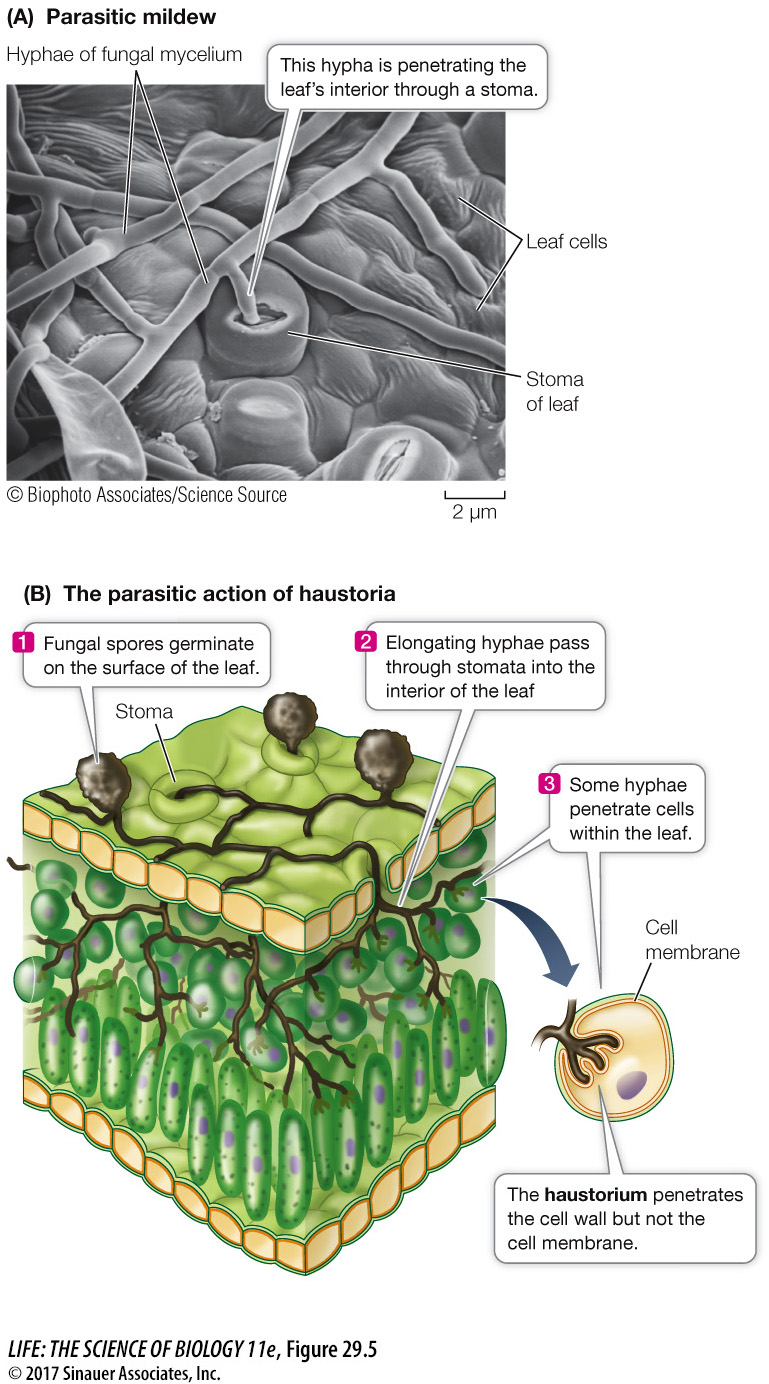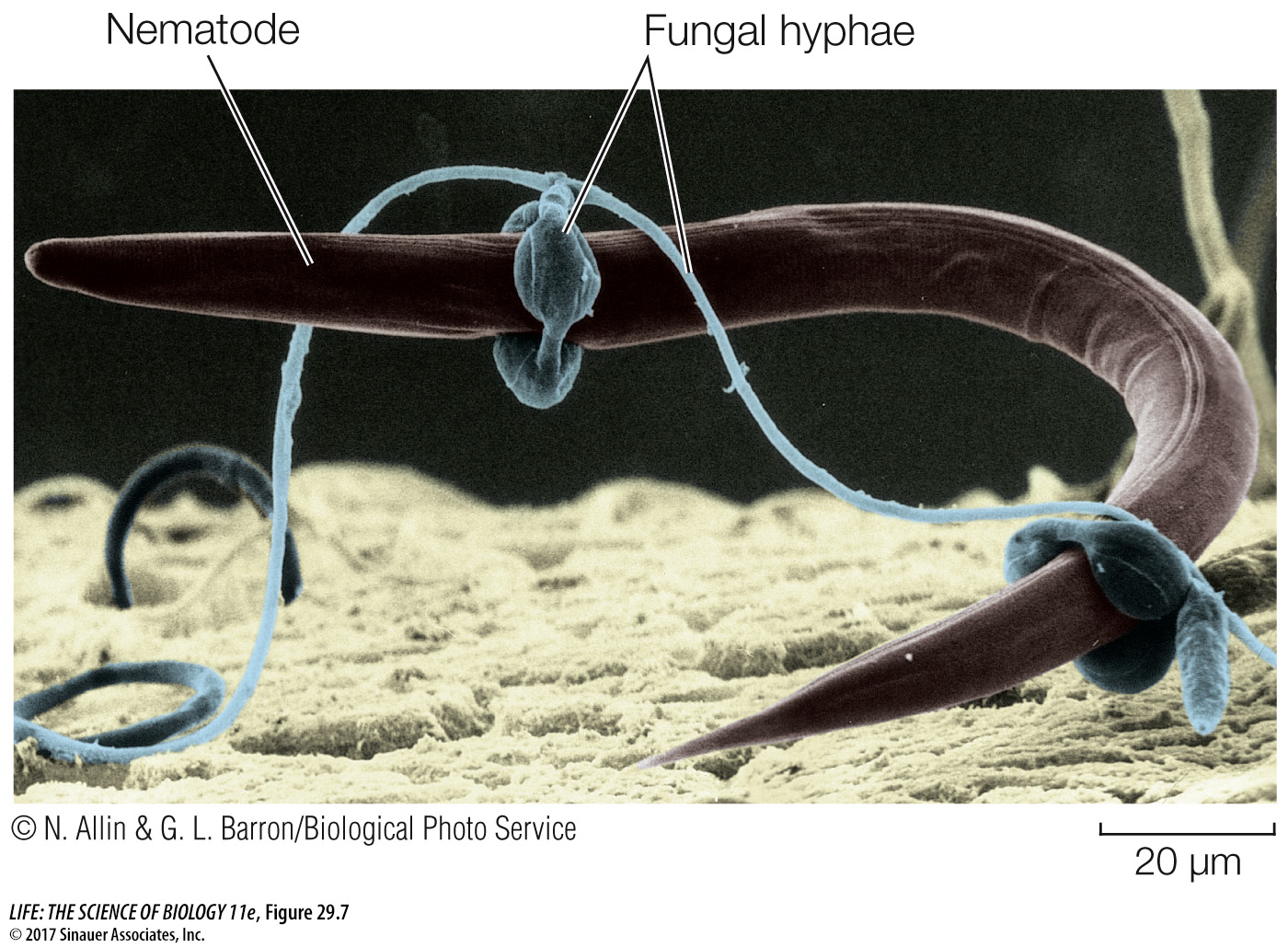Some fungi engage in parasitic or predatory interactions
Whereas saprobic fungi obtain their energy, carbon, and nitrogen directly from dead organic matter, other species of fungi obtain their nutrition from parasitic—
617
PARASITIC FUNGI Mycologists (biologists who study fungi) distinguish between two classes of parasitic fungi based on their degree of dependence on their host. Facultative parasites can grow on living organisms but can also grow independently (including on artificial media). Obligate parasites can grow only on a specific, living host. The fact that their growth depends on a living host shows that obligate parasites have specialized nutritional requirements.
Plants and insects are the most common hosts of parasitic fungi. The filamentous structure of fungal hyphae is especially well suited to a life of absorbing nutrients from living plants. The slender hyphae of a parasitic fungus can invade a plant through stomata, through wounds, or in some cases, by direct penetration of epidermal cell walls (Figure 29.5A). Once inside the plant, the hyphae branch out to expand the mycelium. Some hyphae produce haustoria, branching projections that push through cell walls into living plant cells, absorbing the nutrients within those cells. The haustoria do not break through the cell membranes inside the cell walls, but instead invaginate into the membranes, so that the cell membrane fits them like a glove (Figure 29.5B). Fruiting structures may form, either within the plant body or on its surface.

Some parasitic fungi live in a close physical (symbiotic) relationship with a plant host that is usually not lethal to the plant. Others are pathogenic, weakening or even killing the host from which they derive nutrition.
Media Clip 29.2 Mind-
www.life11e.com/
PATHOGENIC FUNGI Although most human diseases are caused by bacteria or viruses, fungal pathogens are a major cause of death among people with compromised immune systems. Many people with AIDS die of fungal diseases, such as the pneumonia caused by Pneumocystis jirovecii. Even Candida albicans and certain other yeasts that are normally part of a healthy microbiome can cause severe diseases, such as esophagitis (which impairs swallowing), in individuals with AIDS and in individuals taking immunosuppressive drugs. Various fungi cause other, less threatening human diseases, such as ringworm and athlete’s foot. The relatively close relationship between fungi and animals makes it difficult to find drugs that target unique features of fungal metabolism, without harming human patients. As a result, fungal diseases are a growing international health problem.
The worldwide decline of amphibian species has been linked to the spread of a chytrid fungus, Batrachochytrium dendrobatidis (or Bd for simplicity). In some areas of the world where this fungus has been present for millennia, amphibian populations appear to be tolerant of Bd and it does not cause widespread die-
Fungi are by far the most important plant pathogens, causing annual crop losses amounting to billions of dollars. Major fungal diseases of crop plants include black stem rust of wheat and other diseases of wheat, corn, and oats. The agent of black stem rust is Puccinia graminis, which has a complicated life cycle that involves two plant hosts (wheat and barberry). In an epidemic in 1935, P. graminis was responsible for the loss of about one-
experiment

Figure 29.6 What Is the Origin of Amphibian-
Original Paper: Rosenblum, E. B. et al. 2013. Complex history of the amphibian-
An investigation by Erica Rosenblum and colleagues of Batrachochytrium dendrobatidis isolates from around the world suggests that this pathogenic fungus was introduced to western North America several times, from different geographic localities.
618
PREDATORY FUNGI Some fungi have adaptations that enable them to function as active predators, trapping nearby microscopic protists or animals. This feeding strategy is especially important in environments with lots of available carbon, but little nitrogen, such as wood. The most common predatory strategy seen in fungi is to secrete sticky substances from the hyphae so that passing organisms stick to them. The hyphae then quickly invade the trapped prey, growing and branching within it, spreading through its body, absorbing nutrients, and eventually killing it.
A more dramatic adaptation for predation is the constricting ring formed by some species of soil fungi (Figure 29.7). When nematodes (tiny roundworms) are present in the soil, these fungi form three-
